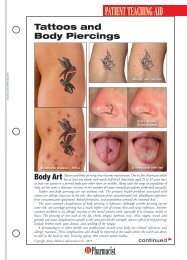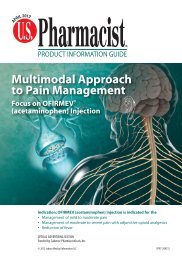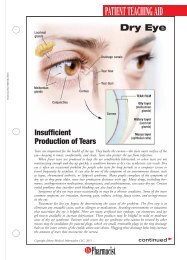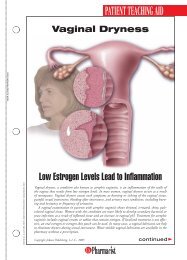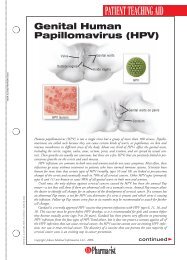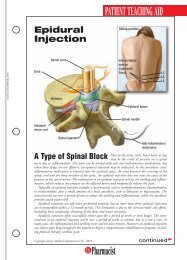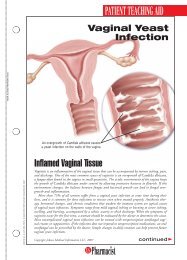View PDF Edition - U.S. Pharmacist
View PDF Edition - U.S. Pharmacist
View PDF Edition - U.S. Pharmacist
Create successful ePaper yourself
Turn your PDF publications into a flip-book with our unique Google optimized e-Paper software.
MedicationsUsed in OpioidMaintenanceTreatmentFor the community pharmacist, the ability to aidin the management of opioid dependence is vitalto closing the gap between treated and untreatedopioid-dependent individuals. In the United States,approximately 2 million adults are dependent onheroin or other nonmedically prescribed opioids, yet onlyabout 14% receive treatment. 1,2 In an effort to providecare to a greater number of patients with dependence oraddiction treatment needs, the Drug Addiction TreatmentAct of 2000 (DATA 2000) was passed. DATA 2000states that physicians who qualify can treat opioid dependencein the office setting with a schedule III, IV, or Vdrug that is FDA-approved for this indication. 3 In 2002,buprenorphine (Subutex) and buprenorphine/naloxone(Suboxone) sublingual tablets were approved for the managementof opioid dependence. As the practice of treatingopioid dependence expands, pharmacists must becomefamiliar with this chronic condition and stay up-to-datewith current treatment options for patients on maintenancetherapy.NEUROBIOLOGY OF OPIOIDDEPENDENCE AND WITHDRAWALOver the past 30 years, much has been discoveredabout opioid dependence that has improved our understandingof addiction as a chronic disease. Opioids activatespecific opioid receptors (mu, delta, and kappa). Initially,when heroin or other short-acting opioids are taken,receptor agonists induce euphoria. Subsequent doses willquickly produce tolerance—the need for increasinglyhigher doses to induce the same effect—and physicaldependence. Currently, it is believed that tolerance is aresult of a reduction in either the number or theresponsivity of opioid receptors. 4,5Chronic exposure to opioids causes upregulation of thecyclic adenosine monophosphate signaling pathways inneurons that are responsible for therelease of noradrenaline. When theinhibitory opioid is no longer present,the firing rates of these neurons areunopposed and result in adrenergic overactivation,which manifests as the constellationof withdrawal symptoms. 4,5Christie Choo, PharmD, BCPSAssistant Clinical ProfessorCollege of Pharmacy and Allied HealthProfessions, St. John’s UniversityJamaica, New YorkClinical Manager–Internal MedicineNew York–Presbyterian/Columbia UniversityMedical Center, New York, New York© MEDI-MATION LTD / PHOTO RESEARCHERS, INCMany characteristics of opioids, especially onset ofaction and half-life, contribute to the potential for dependenceand to the onset of withdrawal. Withdrawal maypresent as anxiety, bone pain, chills, piloerection, sweating,nervousness, nausea, diarrhea, rhinorrhea, or constantyawning. More severe symptoms include hot andcold flashes, increased blood pressure and pulse, mydriasis,abdominal and muscle cramps, and vomiting. Symptomscontinue for 48 to 96 hours after the last dose, butmay persist for weeks to months in some individuals. 6 SeeTABLE 1 for withdrawal profiles of various opioids.PHARMACOLOGIC TREATMENTThere are three major approaches to opioid dependence:opioid detoxification, agonist maintenance, and antagonistmaintenance. Opioid detoxification, also known asmedically supervised withdrawal, is utilized mainly totransition into or out of a maintenance program, over avery short period of time. In antagonist maintenance,naltrexone—an opioid antagonist like naloxone—is used.Unlike naloxone, it can be used orally because of its superiorbioavailability. Unfortunately, neither opioiddetoxification nor antagonist maintenance has proved tobe as efficacious as agonist maintenance for producinglong-term abstinence. 7 However, research is being conductedusing novel approaches like rapid detoxificationunder general anesthesia and subcutaneous naltrexoneimplantation. 8,9To be an effective option for maintenance treatment,an agent must be able to do the following: block theeuphoric and sedating effects of dependent opioids; relievethe cravings (the major cause of relapse); relieve andprevent withdrawal symptoms; permit the patient to participatein society; and allow for at least once-daily dosing.10 The pharmacologic agents that embody these characteristicsand have proven their efficacy are buprenorphine,buprenorphine/naloxone, and methadone(see TABLE 2).Methadone and Levo-AlphaAcetyl Methadol (LAAM)Methadone, a schedule II controlledsubstance, has been the most frequently40U.S. <strong>Pharmacist</strong> • November 2009 • www.uspharmacist.com




